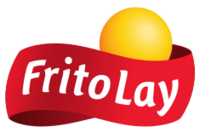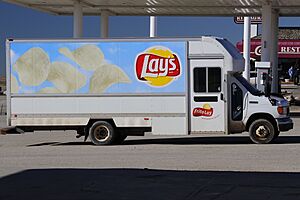Frito-Lay facts for kids

Logo used since February 1997
|
|
| Subsidiary | |
| Industry | Food |
| Predecessors | The Frito Company H.W. Lay & Company |
| Founded | September 1961 |
| Founders | Charles Elmer Doolin Herman Lay |
| Headquarters |
,
U.S.
|
|
Area served
|
Worldwide |
|
Key people
|
Steven Williams (CEO) |
| Products | Snack foods |
| Brands | |
| Revenue | US$15.798 billion (2017) |
| Parent | PepsiCo |
Frito-Lay, Inc. is a big American company that makes and sells many popular snack foods. You probably know some of their snacks, like Lay's potato chips or Doritos! The company started in the early 1930s as two separate businesses. These were The Frito Company and H.W. Lay & Company. They joined together in 1961 to become Frito-Lay.
Later, in 1965, Frito-Lay joined with the Pepsi-Cola Company. This created a huge new company called PepsiCo. Since then, Frito-Lay has been a part of PepsiCo. Some of their most famous snacks include Fritos corn chips, Cheetos cheese snacks, Doritos and Tostitos tortilla chips, and Lay's and Ruffles potato chips. In 2009, each of these brands sold over $1 billion worth of snacks around the world! Frito-Lay, as part of PepsiCo, is the largest snack food company globally.
The Story of Frito-Lay
How The Frito Company Began
The Frito Company started in 1932. A man named Charles Elmer Doolin, from Kansas, bought a corn chip recipe. He also bought a small machine and a list of 19 stores that sold corn chips. He paid $100, which he borrowed from his mother.
Doolin started his new corn chip business in his mother's kitchen. He worked with his mother and brother to make the chips, which they called Fritos. At first, they could only make about 10 pounds of chips each day. They sold the Fritos in small 5-cent bags. They made about $2 in profit each day.
By 1933, they had a new machine that helped them make almost 100 pounds of Fritos daily! The company moved its main office to Dallas, Texas. This was a good spot because it was central and had good access to ingredients. In 1937, The Frito Company opened a special lab to create new products. They added Fritos Peanut Butter Sandwiches and Fritos Peanuts to their snacks.
The company kept growing. In 1941, they opened a new office in Los Angeles. By 1950, Fritos were sold in all 48 states of the U.S. Charles Doolin passed away in 1959. By then, The Frito Company made over 40 different products. They had factories in 18 cities and employed more than 3,000 people. Their sales were over $50 million in 1958. By 1962, Fritos were sold in 48 countries around the world.
The Start of H.W. Lay & Company
Herman Lay was a salesman from North Carolina. In 1931, he started selling potato chips from his car in the Southern United States. In 1932, he began his own potato chip business in Nashville, Tennessee. He worked as a salesman for a company called Barrett Food Products. Eventually, he took over their Nashville warehouse.
Lay hired his first salesman in 1934. Three years later, he had 25 employees and a bigger factory. There, he made popcorn and peanut butter sandwich crackers. In 1938, Herman Lay bought Barrett's factories in Atlanta and Memphis for $60,000. He borrowed money and used company stock to pay for them.
In 1939, Lay moved his main office to Atlanta and started H.W. Lay & Company. He bought more factories in other cities like Jacksonville, Florida. Until 1944, he used the "Gardner" name for his potato chips. Then, he changed the product name to Lay's Potato Chips.
H.W. Lay & Company grew even more in the 1950s. By 1956, it was the biggest maker of potato chips and snacks in the United States. They had over 1,000 employees and factories in eight cities.
Frito-Lay, Inc. is Formed
In 1945, The Frito Company allowed H.W. Lay & Company to make and sell Fritos in the Southeast. The two companies worked closely together. In September 1961, The Frito Company and H.W. Lay & Company officially joined. They became Frito-Lay, Inc., and their main office was in Dallas, Texas. At this time, the new company made $127 million in sales each year. Most of this money came from their four main brands: Fritos, Lay's, Cheetos, and Ruffles.
Joining PepsiCo
In February 1965, Frito-Lay, Inc. and Pepsi-Cola announced they would merge. On June 8, 1965, the shareholders of both companies approved the merger. This created a brand new company called PepsiCo, Inc.. When they merged, Frito-Lay had 46 factories and over 150 distribution centers across the United States.
One big reason for the merger was to help Frito-Lay snacks reach more places. Pepsi-Cola already sold its drinks in 108 countries. This meant Frito-Lay products could now be sold all over the world! Soon after the merger, Frito-Lay snacks started selling internationally. In the U.S., Lay's became the first potato chip brand sold in all 50 states in 1965.
PepsiCo also thought that Frito-Lay snacks and Pepsi-Cola drinks would go well together. The idea was that "Potato chips make you thirsty; Pepsi satisfies thirst."
New Snacks and Challenges (1965–1980)
After joining PepsiCo, Frito-Lay worked on creating new snack brands. Some of these included Doritos (1966), Funyuns (1969), and Munchos (1971). Doritos became the most popular new product from this time. At first, people thought Doritos were a bit plain. So, the company relaunched them with Taco flavor, and later Nacho Cheese flavor. These spicier versions were a big hit! Doritos quickly became Frito-Lay's second most popular product, after Lay's potato chips.
In the 1970s, Frito-Lay faced more competition. Other companies started making their own potato chips and cheese snacks.
Growth and New Ideas (1980–2000)
Frito-Lay bought GrandMa's Cookies in 1980. These cookies started selling across the United States in 1983. In 1978, Frito-Lay created Tostitos, a new type of Mexican tortilla chip. Tostitos Traditional Flavor and Tostitos Nacho Cheese Flavor were sold nationwide by 1980. They quickly became one of Frito-Lay's most successful new products. By 1985, Tostitos was Frito-Lay's fifth-largest brand.
In the late 1980s, Frito-Lay also bought Smartfood, a brand of cheese-flavored popcorn. They started selling it all over the U.S. Sales outside of the U.S. and Canada also grew a lot. By 1989, international sales were $500 million.
The 1990s brought more new products from Frito-Lay. One of the most successful was Sun Chips, a multi-grain chip first sold in 1991. Frito-Lay also made "Baked" versions of Tostitos and Lay's. These new products showed that Frito-Lay wanted to offer healthier snack options. By 1994, Frito-Lay was selling 8 billion bags of chips, popcorn, and pretzels each year!
In 1996, PepsiCo organized its snack food businesses into the "Frito-Lay Company." This company had two main parts: Frito-Lay North America and Frito-Lay International. Frito-Lay also bought other snack companies around the world, like Cracker Jack popcorn in 1997.
Recent History (2000–Present)
In the 2000s, PepsiCo continued to grow its Frito-Lay brands. They expanded internationally and bought other companies. Frito-Lay partnered with companies like Walkers in the UK and Sabritas in Mexico. Because of these partnerships, some Frito-Lay products, like Doritos, are sold under the same name worldwide. But others keep their original local names. For example, Lay's chips are similar to Walkers Crisps in the UK.
In 2001, The Quaker Oats Company joined PepsiCo. This meant Quaker snacks, like Chewy granola bars, became part of the Frito-Lay North America division for a short time. In 2003, Frito-Lay's international business became part of PepsiCo International. Frito-Lay North America continued to handle business in the U.S. and Canada.
Frito-Lay also kept trying new things with its products. In 2002, they introduced Reduced Fat Lay's and Cheetos. They also added Baked Doritos. In 2003, Frito-Lay launched its "Natural" line of products. These were made with ingredients that were grown organically. Examples included Organic Blue Corn Tostitos and Natural Lay's Potato Chips with sea salt.
In 2010, Frito-Lay changed its Lay's Kettle and Lay's flavored chips to be made with all-natural ingredients. Sales of Lay's potato chips grew by 8% after this change. Because of this success, Frito-Lay announced plans to make about half of all its products with all-natural ingredients in 2011. This included Sun Chips, Tostitos, Fritos, and Rold Gold pretzels.
How Frito-Lay Operates
As of 2010, Frito-Lay has factories, distribution centers, and offices in over 40 countries. Its main office for North America is in Plano, Texas. In North America, Frito-Lay has about 1,830 distribution centers, warehouses, and offices. They also have 55 factories. Steven Williams is the current chief executive officer.
Frito-Lay in North America
PepsiCo Americas Foods handles PepsiCo's food and snack businesses in North and South America. This includes Frito-Lay North America, Sabritas, Gamesa, and Latin America Foods. Frito-Lay North America Inc. is the part of the company that handles creating, selling, and distributing Frito-Lay products in the U.S. and Canada.
Their main brands include Lay's and Ruffles potato chips, Doritos tortilla chips, Tostitos tortilla chips and dips, Cheetos cheese snacks, Fritos corn chips, Rold Gold pretzels, Sun Chips, and Cracker Jack popcorn. Frito-Lay sells these products to stores and other sellers. They transport the snacks from their factories to distribution centers using their own trucks.
Sabritas and Gamesa are two of PepsiCo's snack businesses in Mexico. PepsiCo bought Sabritas in 1966 and Gamesa in 1990. Sabritas sells Frito-Lay products like Cheetos, Fritos, Doritos, and Ruffles in Mexico. Gamesa is the biggest cookie maker in Mexico.
Frito-Lay Around the World
PepsiCo's Latin Americas Foods sells Frito-Lay snacks in Central and South America. They sell brands like Lay's, Cheetos, Ruffles, and Doritos. They also have local brands like Fandangos in Brazil.
In Europe, the PepsiCo Europe division makes Frito-Lay brands. These include Doritos, Lay's, Cheetos, and Twistos. In the United Kingdom and Ireland, PepsiCo's company Walkers is the main brand, and Lay's is not used. PepsiCo has large factories in England that make snacks. In Spain and Portugal, the company uses the Matutano brand.
Frito-Lay products sold in Asia, the Middle East, and Africa are a smaller part of the company's sales. However, their sales are growing quickly in these areas. While some global Frito-Lay brands are sold there, many snacks are made to fit local tastes. For example, in India, they have Kurkure Twisteez, which are potato snacks with popular Indian flavors.
In Indonesia, Frito-Lay products are made by PT PepsiCo Indonesia Foods and Beverages. They make Cheetos, Lay's, and Doritos for the Indonesian market.
Frito-Lay Products
Frito-Lay makes many different snacks. The types of snacks they sell can be different in each country. PepsiCo divides its snacks into two main groups: those made in North America and those made outside of North America. In some parts of the world, the company's snacks have different names. For example, they are called Sabritas in Mexico, Elma Chips in Brazil, and Walkers in the UK.
The main snack brands under the Frito-Lay name include Fritos corn chips, Cheetos cheese snacks, Doritos and Tostitos tortilla chips, Lay's potato chips, and Ruffles chips. Each of these brands sold over $1 billion worth of snacks worldwide in 2009. Frito-Lay also makes snacks that are not chips. These include Rold Gold pretzels, Cracker Jack popcorn snacks, and TrueNorth nut clusters.
In India, Frito-Lay uses its international brands and also Uncle Chipps, a local brand they bought in 2000. Kurkure, an Indian snack made by PepsiCo India, is now also sold in Canada, the UAE, and the Gulf region. In Poland, there is a brand called 'Star Chips'. A Polish version of Lay's also exists there.
See also
 In Spanish: Frito-Lay para niños
In Spanish: Frito-Lay para niños


